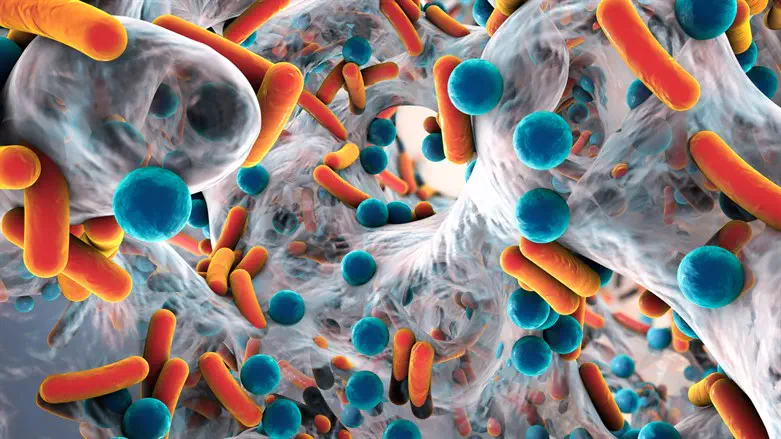
Government coalitions often dissolve when too many parties disagree on too many issues. Even if a coalition seems stable for some time, a small crisis can cause a chain reaction that eventually causes the system to collapse.
A study conducted in the Department of Physics at Bar-Ilan University demonstrates that this principle also holds true for ecosystems, particularly bacterial ecosystems.
In an ecosystem, different species can have a negative effect on one another. The cheetah, for example, preys on the zebra and trees in the jungle compete with one another for sunlight. Conversely, species can positively affect one another, like the bee that pollinates flowers. In the 1970s, the renowned mathematician and biologist Robert May predicted the collapse of coalitions in ecosystems, such as trees in rainforests, animals in savannahs, or fish in coral reefs.
According to May, an ecosystem can become unstable and collapse if it contains too many species, or if the networks of connections between them are too intense. In other words, according to May's theory, small ecosystems in nature are generally characterized by strong bonds, while large systems are characterized by weak bonds. Until now May's theory has been difficult to prove due to the difficulty of measuring these networks.
In the new study, published in Nature Ecology & Evolution, Yogev Yonatan and Guy Amit from the research group of Dr. Amir Bashan of Bar-Ilan University's Department of Physics, in collaboration with Dr. Yonatan Friedman of the Hebrew University, demonstrated the first evidence of May's theory in microbial ecosystems.
The microbiome is of great importance to our health -- such as digestion and absorption of nutrients and training of our immune system. Disruptions in the ecological balance is associated with many ill effects on our physical and mental well-being, from obesity to mental and various psychiatric conditions, and the risk of chronic diseases such as diabetes and cancer. Some interventions which have been introduced to maintain a healthy balance include dietary elements, probiotic intake, antibiotics, and fecal transplantation.
Outside the human body, bacteria play a vital role in creating the living conditions of larger organisms. They are necessary for nutrient decomposition, regulation of production and decomposition of gases in the atmosphere, including greenhouse gases, methane, carbon dioxide, and more.
The researchers developed a novel computational method that allows the level of connectivity in the ecosystem (a measure of the number of connections in the network and their strength) to be estimated by analyzing large amounts of data from a variety of microbial communities without having to create a detailed map of all the interactions – analogous to how the temperature of a glass of water can be measured without complete knowledge of the velocity and position of each water molecule.
Initially, the researchers tested the new method on simulated data of ecological dynamics. Later on, they analyzed data from thousands of samples of bacterial populations from various organs in the human body and from bacterial populations that live on marine sponges in coral reefs in various sites around the world. In each ecological environment, they compared the number of different species in the bacterial population and the level of connectivity of the ecological network, and found initial evidence of the existence of Robert May's principle of stability in these systems.
Understanding the stability principles of bacterial communities is important for two reasons. Stability principles are the rules of the game that dictate the evolution of the ecosystem in a particular environment and help answer scientific questions such as why different bacterial populations develop in different places, or why the number of species differs between places.
A second reason is that ecosystems may collapse as a result of disturbing the ecological balance following human intervention. This is true of coral reefs in Australia and rainforests in Brazil, and it is also true of bacterial populations in humans and in the environment. It is important to assess how close these systems are to collapse so that we know how to avoid damaging them and how they can be rehabilitated.
The results show that the number of different species of bacteria that can survive in the same ecological environment is limited by the strength of the interactions between them. For example, in the gut, where there is an abundance of food for bacteria and less intense competition for resources, we find dozens to hundreds of different types of bacteria. The opposite occurs in other places where competition is fierce and the number of species is small.
Understanding the stability principles of bacterial populations is especially important when we are interested in developing treatments that include attempts to influence, change, and control their composition. Therefore, understanding the ecological laws that govern the bacterial populations in man and the world is very important both for the development of medical treatments and for preservation of the environment.
The topic of this research, which is generally studied by life sciences researchers, is an example of a growing trend in recent years toward multidisciplinary research, in which complex problems are explored by experts from various disciplines. In this study physicists used tools from the fields of statistical physics, nonlinear dynamics, network science, and data science to study problems characterized by large amounts of data, of which networks in bacterial populations or diverse human interactions are only a part.
